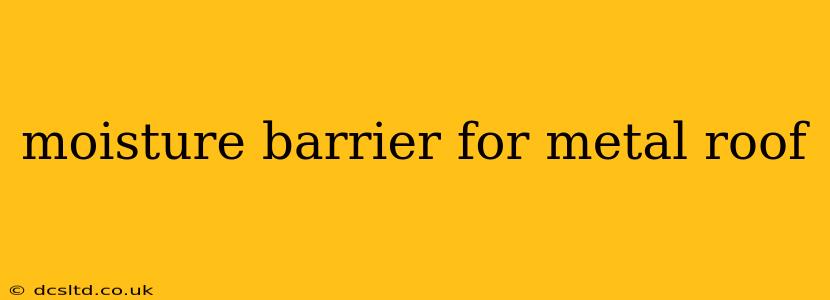Metal roofs are increasingly popular due to their durability, longevity, and aesthetic appeal. However, proper installation, including the use of a reliable moisture barrier, is crucial to prevent costly damage and ensure the roof's lifespan. This comprehensive guide explores the importance of a moisture barrier for metal roofs, addressing common questions and concerns.
Why is a Moisture Barrier Important for a Metal Roof?
A moisture barrier is a critical component of any metal roofing system. Its primary function is to prevent moisture from entering the roofing system and causing damage. Metal roofs, while highly resistant to weather elements, are not impervious to moisture intrusion. Moisture can enter through gaps, seams, or even penetrate the metal itself under certain conditions. This moisture can lead to:
- Corrosion: Moisture can cause rust and corrosion of the metal roofing panels, significantly reducing their lifespan and structural integrity.
- Mold and Mildew Growth: Trapped moisture provides the perfect environment for mold and mildew to thrive, impacting indoor air quality and potentially causing health problems.
- Wood Rot and Decay: If the moisture reaches the underlying wooden decking, it can lead to rot and decay, requiring expensive repairs or even roof replacement.
- Insulation Degradation: Moisture can compromise the effectiveness of roof insulation, leading to higher energy bills and reduced thermal comfort.
What are the Different Types of Moisture Barriers?
Several types of moisture barriers are suitable for metal roofing systems:
- Synthetic Underlayments: These are popular choices, often made from polyethylene or polypropylene. They offer good moisture resistance, are relatively inexpensive, and are easy to install.
- Rubberized Asphalt Underlayments: Providing excellent waterproofing, these are durable and offer superior protection against tears and punctures.
- Metal-Specific Underlayments: Designed specifically for metal roofing, these may incorporate features such as UV protection and breathability to prevent moisture buildup.
How is a Moisture Barrier Installed on a Metal Roof?
The installation of a moisture barrier is crucial and should be done correctly to maximize its effectiveness. Generally, it's installed directly onto the roof decking before the metal roofing panels are placed. Overlapping seams are essential to prevent water penetration, and proper fastening is required to ensure it remains secure.
What Happens if a Moisture Barrier Fails?
A failed moisture barrier can lead to significant problems, including those mentioned earlier – corrosion, mold growth, wood rot, and insulation degradation. The severity of the damage depends on the extent of moisture intrusion and the length of time it's been present. Early detection is vital to mitigate damage and prevent costly repairs.
How Often Should a Moisture Barrier be Inspected?
Regular roof inspections are recommended to detect any issues early. While the moisture barrier itself isn't typically visually inspected frequently (unless there’s significant damage visible around the flashing or edges), inspecting for signs of leaks or moisture damage on the interior of the building will signal a potential problem with the barrier.
Is a Moisture Barrier Necessary Under a Metal Roof?
While not always strictly mandated by building codes in every region, using a moisture barrier beneath a metal roof is highly recommended. The potential for long-term damage and costly repairs far outweighs the relatively small cost of the material and installation. The peace of mind knowing your roof is properly protected makes it a worthwhile investment.
Can I Install a Moisture Barrier Myself?
While DIY installation is possible for some individuals with prior experience in roofing, it is often recommended to hire a qualified professional roofer. Incorrect installation can compromise the effectiveness of the barrier, leading to future problems. Professionals are trained in proper installation techniques and can ensure a long-lasting, leak-proof roof.
This comprehensive guide aims to equip you with the knowledge needed to understand the significance of moisture barriers in metal roofing systems. Remember, selecting the right moisture barrier and ensuring proper installation are key to maximizing the lifespan and performance of your metal roof.
